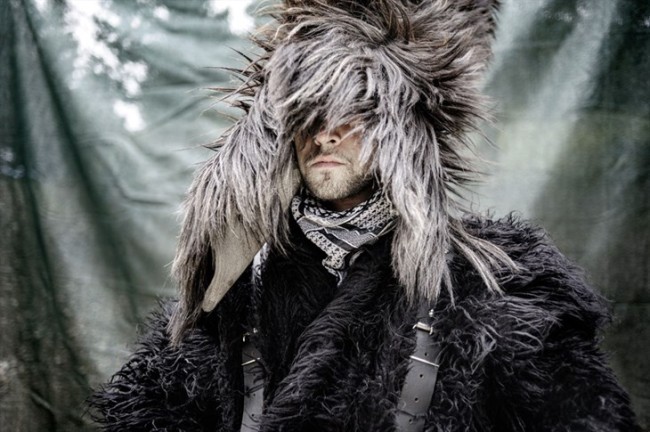For all those with origins in Northern Greece, Nick Vavdinoudi’s photos are set to awaken childhood memories, whether in the form of images, sounds or stories told by parents and grandparents.
The ‘Faces+Masks’ series − soon to be exhibited at the Hellenic Museum as part of the Melbourne Fashion Festival − depicts the obscure yet fascinating ‘Bell Bearers’ tradition, which is still practised in the rural areas of the Drama and Kavala prefecture.
Dressed in elaborate, animalistic costumes, bells strapped around their waists and with their faces covered by ashes or animal skins, the participants in the photographs take up the role of initiator for the viewer.

The rituals are said to date back to the ancient Greek celebrations honouring Dionysus, who is considered, according to the myth, the god of resurrection among other things, having died and been reborn three days later.
The rituals have survived to the present day in the form of a festival celebrated from the 6-8 January in rural Eastern Macedonia as a symbolic way for local inhabitants to cast out the evil spirits and welcome a year of fertility and productivity.
The fact that the beginning of the festival coincides with the Orthodox Christian holiday of Epiphany serves as proof of the harmonic coexistence of ancient Greek/pagan elements and religious tradition.

The photo shoot took place in eight villages in Eastern Macedonia − Monastiraki, Xiropotamos, Petrousa, Pyrgoi, Volakas, Pagoneri, Kali Vrysi and Nikisiani − featuring the costumes from these regions.
In a previous interview with Neos Kosmos, Vavdinoudis revealed that one of the biggest challenges had been to convince locals to participate.
“Once that was achieved, the rest was easier. They started to call people from nearby villages, and for two years weekends were filled with the deafening noise of bells that were worn on the locals’ waists. They stood in front of the camera naturally and I didn’t have to make any corrections.”

People were photographed in natural settings and familiar surroundings, while artificial lighting and special effects are used in some of the pictures to bring to the surface an underlying perspective of the disguised: the person behind the mask.
In this sense, the artist projects his personal perspective of the traditional custom performed rather than engaging in an ethnographic documentation of those practices.
Vavdinoudis’ ‘Faces+Masks’ won second place in the People & Cultures portfolio − TRIBES, in the international competition Travel Photographer of the Year, among thousands of entries from around the world, and his photographs were later exhibited in the prestigious Royal Geographical Society’s gallery in London.
Two years ago, having his photographic series showcased in Melbourne was, according to Vavdinoudis, unfeasible. “Honestly, I have thought about presenting my work to Greek Australians. But the costly transfer of the exhibitions to a destination such as Australia is a concern. This, combined with the current economic situation in Greece, makes it difficult to cover the costs,” he said then.
Yet with ‘Faces+Masks’ scheduled to be showcased at the Hellenic Museum this coming March during the Melbourne Fashion Festival, what looked like a dream is now becoming reality.

Hellenic Museum’s CEO John Tatoulis − who also admits to being an admirer of the artist − explains that the exhibition was selected after extensive research on the topic, which brought to the spotlight the unique story behind each one of the pictures.
“It is a particular series looking at the subject in a way that is quite fascinating, presenting this pagan ritual custom that has evolved from pre-Christian times to now.
“[The artist] is uncovering a lot more about the different characters depicted in the people dressed up, by having the locals partly out of costumes and revealing the actual faces of the individuals,” he says.
Mr Tatoulis also makes special reference to the unique way that the work encapsulates the non-contradiction of the ancient tradition with modern culture.
“There is a contemporary aspect to it, but at the same time it feels incredibly organic.
“You can even see the similarities with film and television, where creators are looking for inspiration into some of these customs and traditions and reinvented them; take Game of Thrones, for example,” he says with a laugh.

This is the second year that the Hellenic Museum is partnering with Melbourne Fashion Festival and according to Mr Tatoulis, the festival organisers were quite excited about the collaboration and the photographic exhibition as something different and unusual.
As for the museum, the partnership also comes as part of an effort to boost the Greek presence in popular events and festivals in the city.
“I think we have an opportunity to work with all the major Melbourne festivals − food, fashion, film − and introduce aspects of Greek art and culture that aren’t necessarily typical … thinking outside the box and offering something adventurous and cutting edge,” explains Mr Tatoulis.
The ‘Faces+Masks’ series will be hosted at the Hellenic Museum from 9-19 March, Tuesday-Sunday from 10.00 am-4.00 pm and entrance is free. Opening night is scheduled for Thursday 9 March from 6.30 pm-8.30 pm.









